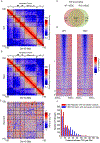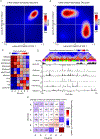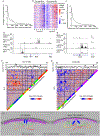Lamins Organize the Global Three-Dimensional Genome from the Nuclear Periphery
- PMID: 30201095
- PMCID: PMC6886264
- DOI: 10.1016/j.molcel.2018.05.017
Lamins Organize the Global Three-Dimensional Genome from the Nuclear Periphery
Abstract
Lamins are structural components of the nuclear lamina (NL) that regulate genome organization and gene expression, but the mechanism remains unclear. Using Hi-C, we show that lamins maintain proper interactions among the topologically associated chromatin domains (TADs) but not their overall architecture. Combining Hi-C with fluorescence in situ hybridization (FISH) and analyses of lamina-associated domains (LADs), we reveal that lamin loss causes expansion or detachment of specific LADs in mouse ESCs. The detached LADs disrupt 3D interactions of both LADs and interior chromatin. 4C and epigenome analyses further demonstrate that lamins maintain the active and repressive chromatin domains among different TADs. By combining these studies with transcriptome analyses, we found a significant correlation between transcription changes and the interaction changes of active and inactive chromatin domains These findings provide a foundation to further study how the nuclear periphery impacts genome organization and transcription in development and NL-associated diseases.
Keywords: 3D genome; Hi-C; HiLands; LADs; TADs; histone and lamina landscape; lamin; lamina-associated chromatin domains; nuclear lamina; transcription.
Copyright © 2018 Elsevier Inc. All rights reserved.
Conflict of interest statement
Declaration of Interests
The authors declare no competing interests.
Figures






Similar articles
-
Role of lamins in 3D genome organization and global gene expression.Nucleus. 2019 Dec;10(1):33-41. doi: 10.1080/19491034.2019.1578601. Nucleus. 2019. PMID: 30755082 Free PMC article. Review.
-
To be or not be (in the LAD): emerging roles of lamin proteins in transcriptional regulation.Biochem Soc Trans. 2022 Apr 29;50(2):1035-1044. doi: 10.1042/BST20210858. Biochem Soc Trans. 2022. PMID: 35437578 Free PMC article. Review.
-
Depletion of lamins B1 and B2 promotes chromatin mobility and induces differential gene expression by a mesoscale-motion-dependent mechanism.Genome Biol. 2024 Mar 22;25(1):77. doi: 10.1186/s13059-024-03212-y. Genome Biol. 2024. PMID: 38519987 Free PMC article.
-
Spatial chromatin organization and gene regulation at the nuclear lamina.Curr Opin Genet Dev. 2019 Apr;55:19-25. doi: 10.1016/j.gde.2019.04.008. Epub 2019 May 18. Curr Opin Genet Dev. 2019. PMID: 31112905 Free PMC article. Review.
-
Identification of lamin B-regulated chromatin regions based on chromatin landscapes.Mol Biol Cell. 2015 Jul 15;26(14):2685-97. doi: 10.1091/mbc.E15-04-0210. Epub 2015 May 20. Mol Biol Cell. 2015. PMID: 25995381 Free PMC article.
Cited by
-
Loss of CRWN Nuclear Proteins Induces Cell Death and Salicylic Acid Defense Signaling.Plant Physiol. 2019 Apr;179(4):1315-1329. doi: 10.1104/pp.18.01020. Epub 2019 Jan 29. Plant Physiol. 2019. PMID: 30696746 Free PMC article.
-
Cell-type-specific role of lamin-B1 in thymus development and its inflammation-driven reduction in thymus aging.Aging Cell. 2019 Aug;18(4):e12952. doi: 10.1111/acel.12952. Epub 2019 Apr 9. Aging Cell. 2019. PMID: 30968547 Free PMC article.
-
Radial Organization in the Mammalian Nucleus.Front Genet. 2020 Feb 12;11:33. doi: 10.3389/fgene.2020.00033. eCollection 2020. Front Genet. 2020. PMID: 32117447 Free PMC article. Review.
-
Lamin A/C Mechanotransduction in Laminopathies.Cells. 2020 May 24;9(5):1306. doi: 10.3390/cells9051306. Cells. 2020. PMID: 32456328 Free PMC article. Review.
-
The Interplay between Oxidative Stress and the Nuclear Lamina Contributes to Laminopathies and Age-Related Diseases.Cells. 2023 Apr 25;12(9):1234. doi: 10.3390/cells12091234. Cells. 2023. PMID: 37174634 Free PMC article. Review.
References
Publication types
MeSH terms
Substances
Grants and funding
LinkOut - more resources
Full Text Sources
Other Literature Sources

